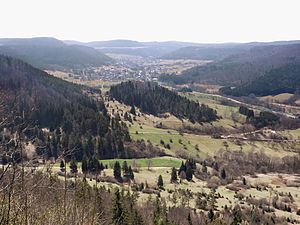Reichenbach and Killertal between Hechingen and Burladingen
|
FFH area "Reichenbach and Killertal between Hechingen and Burladingen"
|
||
|
Killer valley |
||
| location | Zollernalbkreis , Baden-Württemberg , Germany | |
| Identifier | DE-7620-311 | |
| WDPA ID | 555623525 | |
| Natura 2000 ID | DE7620311 | |
| FFH area | 18.49 km² | |
| Geographical location | 48 ° 20 ' N , 9 ° 3' E | |
|
|
||
| Setup date | January 1, 2015 | |
| administration | Regional Council Tübingen | |
The FFH area Reichenbach and Killertal between Hechingen and Burladingen is located in the middle of Baden-Württemberg and is part of the European Natura 2000 network of protected areas . It was designated in 2015 by merging the two FFH areas Reichenbach and Killertal, which had already existed since 2005, and areas near Burladingen by the Tübingen regional council.
location
The Reichenbach and Killertal protected area between Hechingen and Burladingen, around 1849 hectares (acres) in size, is located in the natural areas of the Southwestern Alb foreland , Middle Kuppenalb and High Swabian Alb . The seven sub-areas are located in the municipalities of Burladingen , Hechingen and Jungingen in the Zollernalb district .
description
The nature of the landscape of the protected area is essentially shaped by the deeply cut valley of the Starzel and its tributaries (including the Reichenbach ) as well as numerous juniper heaths.
history
The protected area was created by merging the original FFH areas 7720-341 “Areas near Burladingen” and 7620-342 “Reichenbach and Killertal”. These have existed since 2005.
Protection purpose
Habitat types
The following habitat types according to Annex I of the Habitats Directive occur in the area:
| EU code |
* | Habitat type (official name) | Short name |
|---|---|---|---|
| 3150 | Natural eutrophic lakes with magnopotamion or hydrocharition vegetation | Natural nutrient-rich lakes | |
| 3260 | Rivers of the planar to montane level with vegetation of the Ranunculion fluitantis and the Callitricho-Batrachion | Running waters with flooding aquatic vegetation | |
| 4030 | Dry European heaths | Dry heaths | |
| 5130 | Formations of Juniperus communis on limestone heaths and lawns | Juniper Heath | |
| 6110 | * | Gap basophilic or lime pioneer lawn (Alysso-Sedion albi) | Lime pioneer lawn |
| 6210 | Near-natural dry lime lawns and their stages of shrubbery (Festuco-Brometalia) | Lime grassland | |
| 6410 | Pipe grass meadows on lime-rich soil, peaty and clayey-silty soils (Molinion caeruleae) | Pipe grass meadows | |
| 6430 | Moist tall herbaceous vegetation of the planar and montane to alpine level | Moist tall herbaceous vegetation | |
| 6510 | Lean lowland hay meadows (Alopecurus pratensis, Sanguisorba officinalis) | Lean, lowland hay meadows | |
| 7220 | * | Tufa springs (cratoneurion) | Tufa springs |
| 7230 | Lime-rich fens | Lime-rich fens | |
| 8160 | * | Calcareous debris heaps of the colline to montane level of Central Europe | Lime debris heaps |
| 8210 | Limestone cliffs with crevice vegetation | Limestone cliffs with crevice vegetation | |
| 8310 | Caves that are not open to tourists | Caves and balms | |
| 9130 | Woodruff beech forest (Asperulo-Fagetum) | Woodruff beech forest | |
| 9150 | Central European orchid-lime-beech forest (Cephalanthero-Fagion) | Orchid beech forests | |
| 9180 | * | Mixed ravine and hillside forests (Tilio-Acerion) | Mixed ravine and hillside forests |
| 91E0 | * | Alluvial forests with Alnus glutinosa and Fraxinus excelsior (Alno-Padion, Alnion incanae, Salicion albae) | Alluvial forests with alder, ash, willow |
Species inventory
The following types of community interest exist in the area:
| image | EU code |
* | Art | scientific name | Species group |
|---|---|---|---|---|---|

|
1014 | Narrow diaper snail | Vertigo angustior | Snails | |

|
1078 | * | Spanish flag | Callimorpha quadripunctaria | Butterflies |

|
1093 | * | Stone cancer | Austropotamobius torrentium | Crayfish |

|
1163 | Bullhead | Cottus gobio | Fish and round mouths | |

|
1193 | Yellow-bellied toad | Bombina variegata | Amphibians | |

|
1323 | Bechstein's bat | Myotis bechsteinii | Mammals | |

|
1324 | Great mouse ear | Myotis myotis | Mammals | |

|
1902 | Yellow lady's slipper | Cypripedium calceolus | plants |
Contiguous protected areas
The following nature reserves are part of the FFH area:
See also
Individual evidence
- ↑ a b c Tübingen regional council (ed.): Management plan for the Natura 2000 area 7620-311 "Reichenbach and Killertal between Hechingen and Burladingen" . edited by INA Südwest (W. HERTER, M. BRÄUNICKE, M. KOLTZENBURG, TH LIMMEROTH, K.-J. MAIER, R. STEINER, R. STRAUB, J. TRAUTNER, J. TREITLER, H. TURNI). April 29, 2014 (228 pp., Baden-wuerttemberg.de [PDF]).
Web links
- Standard data sheet for the FFH area "Reichenbach and Killertal between Hechingen and Burladingen"
- Profile of the FFH area in the LUBW's list of protected areas
- Regional Council Tübingen (Ed.): Management plan for the Natura 2000 area 7620-311 "Reichenbach and Killertal between Hechingen and Burladingen" . edited by INA Südwest (W. HERTER, M. BRÄUNICKE, M. KOLTZENBURG, TH LIMMEROTH, K.-J. MAIER, R. STEINER, R. STRAUB, J. TRAUTNER, J. TREITLER, H. TURNI). April 29, 2014 (228 pp., Baden-wuerttemberg.de [PDF]).

